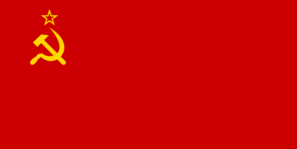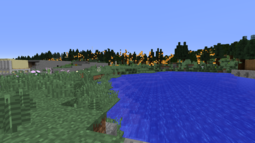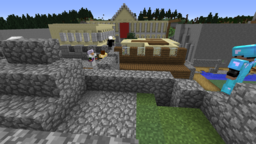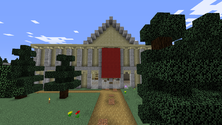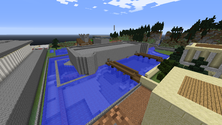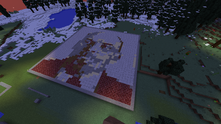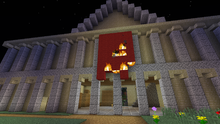Petrograd (Classic)
Introduction
Petrograd (officially known as the Soviet Republic of Petrograd) is the administrative capital of Union of Soviet Socialist Republics. It is situated near the border of Soviet Finland and the Baltic Sea. Petrograd is a large city, with lots of living space in Soviet-style apartments. The town also includes a small industrial complex and also a large sub-surface mine supplying a vast amount of resources. The city is also surrounded by a large amount of fertile land which is in process of being converted into agricultural usage.
History of Petrograd
Establishment, The Soviet-Irish War & The establishment of the Soviet Union.
Petrograd was first founded toward the end of June 2017. It was founded by Borgatrotskyist and Nicholaspoul. The town was quickly griefed by Kusumo and the town was sabotaged by cobble monsters which were placed around the city. The Smolny Institute was covered in Lava and the foundations were burned to the ground. After an admin repaired the almost inevitable damage caused by the raid, Ireland sent undercover agents into the Soviet Union and stole the nation's resources in multiple sabotage attempts. In retaliation, Petrograd used a Caesar-style tactic and built a wall around them. This strategy went horribly and the Soviet-Irish War started after declarations from both participants. The Soviet Union planned to completely surround and starve Ireland. The conflict lasted for a long period of time and ended in a stalemate between Irish and Soviet forces. Both belligerents agreed to end their outposts located in each other's nations. The Soviet Union dismantled their outpost but Irish forces double-crossed the Soviet union and kept their outpost of Talamh.
The aftermath of the Soviet-Irish War and the Battle of Petrograd.
The Irish later demanded all the gold which was stored in Petrograd, to prevent the further growing Irish threat the Soviet Union was established. After the formation of the Soviet Union, a coalition composed of Russian nationalists and monarchists alike and also fighters who wished to prevent the growth of the Marxist-Leninist nation marched towards Petrograd in which they burned all the surrounding forests and fought in 'The Hill' otherwise known as the Coalition Fortress. This fortress was composed of a hideous lump of cobblestone and walls (later demolished by Vlad1mir_Lenin for the development of the now non-existent 'Hammer & Sickle Monument for the Workers'). The battle between Coalition Forces and the Red Army ended in a stalemate, resulting in the fortification and rapid expansion of Petrograd. The Russian Empire, attempting to ally the Soviet Union, was denied of this alliance request and was declared an enemy to the Soviet Union. The Russian Empire established St. Petersburg shortly after foundation, which leads the expansion of both Petrograd and St. Petersburg in a gamble to protect both towns from each other.
The arrival of Vladimir Lenin and the Three Week Plan.
On the 16th of August 2017, a new socialist economic policy took power in Petrograd. This lead to the vast increase in the industrialisation of Petrograd and also a vast increase in general resource production and collectivisation. The plan has also lead to the vast exportation and importation of resources from other Soviet Republics within the Soviet Union to help the development of all towns within the USSR. These reforms have significantly grown mining and agricultural activity within Petrograd and utilised the new increased activity within the city. Immigration has helped increase the effectiveness of the Three Week Plan and has also lead to the construction of new residential apartment buildings which now make up a vast number of the buildings within Petrograd. The plan has also lead to the development of 'Labour Vouchers' which are still planned to be voted into power.
On the 17th of August 2017, revolutionary Vladimir Lenin, an enthusiast in Russian History and also the history of the Soviet Union applied for citizenship of Petrograd after the failure to establish a self-reliant Soviet State in Murmansk, Kola Peninsula as it was griefed by locals (possibly Swedes who knows). He was informed that the USSR already existed and devoted his time to travel to Petrograd in the 'Voyage of Karelia'. After joining Petrograd, he began vast construction projects such as the 'Hammer & Sickle Monument for the Workers' (now-defunct and scrapped), underground extensions to the Smolny Institute, 'The Palace of Soviets' and 'Lenin Square'. The Coalition Castle (otherwise known as 'The Hill') and parts of Talamh and St Petersburg have all been cleared to make way for these new projects. He also brought a vast surge of reactivity to Petrograd and the continued mining and industrial actions which have increased due to his arrival. After a week of development of all these building projects, it leads us to the current state of Petrograd. New canal projects and apartment projects are currently underway alongside Vladimir Lenin's construction projects.
Monuments & Buildings of Petrograd
Petrograd has a lot of planned monuments and buildings. Currently, only two major monuments based on historical Petrograd; The Peter-paul fortress (incomplete) and the town The Smolny Institute. These structures were both built prior to the Russian Revolution however historically they were repurposed for the Soviet Union after the Russian Revolution. The Peter-Paul fortress was home to the Trubetskoi Bastion Prison which hosted Leon Trotsky as a political prisoner. The Smolny Institute is currently used as the main administrative capital building hosting the Congress of Petrograd and the Bolshevik Party.
Other major monuments include Lenin Square, a square built to look like Vladimir Lenin, the revolutionary which helped the creation of the Union of Soviet Socialist Republics and was a key figure in the Russian Civil War and also the October Revolution and Russian Revolution. The Palace of Soviets, which is planned to be based on the historical Palace of Soviets which was never built, planned to be originally constructed in Moscow. The Palace of Soviets was designed to be an influential building to represent the true power of the Soviet Union and the workers. The Palace of Soviets is being constructed on what remains of the fortress constructed by coalition forces (nicknamed 'The Hill' by Borgartrotskyist) which scrambled to fight Petrograd after the Soviet Union was established, also it is being constructed onto the current claims of the abandoned Irish outpost of Talamh. Construction of the Palace of Soviets is still underway and may take several months of progress and construction. The Palace of Soviets will house the Bolshevik Party and many foreign embassies and meeting areas for allies of the Soviet Union.
Other buildings of Petrograd are either residential or used for industry and the collectivisation of resources and also the planned Soviet economy. These buildings are all managed by the workers and the Party. The residential buildings of Petrograd are completely free for immigration and new residents of Petrograd.
Constitution of Petrograd
The Constitution of the Soviet Republic of Petrograd goes as follows:
- The Petrograd Soviet recognises the 3 political freedoms: Freedom of speech, Freedom of press and Freedom of assembly into any faction or party.
- The Soviet recognises all rights founded in the fundamental laws of the Soviet.
- All ranks must be elected by a motion submitted by any resident.
- Petrograd declares itself a Minecraft Soviet republic. Meaning the collective ownership of resources, mines and farms; run in the interests of its citizens.
- No player will live in a shack or die from hunger because he can’t afford to buy items within his own town!
- As in any Soviet republic, the fundamental power of society is in its citizen in a participatory democracy, the Soviet balances representative democracy and direct democracy.
- Any citizen can call for an election on a representative, with the results being published in 10 days.
- Any citizen can submit a motion to any branch of government which must be voted on.
- The mayor like any position can be removed by popular vote.
- All decision made by the governing majority must be followed out full heartily by any minority. The minority cannot obstruct or disobey the actions of the decision of the majority and their representative.
- In a crisis, the mayor or the vote or consensus of online commissars can make a decision without a vote, as emergency powers.
- All information about town politics and event must be published for the public in an unbiased manner.
- In addition to the mayor, the position of commissar of public works is created, which involves coordinating and suggest public work projects which contribute to the development of Petrograd.
- Of course, any citizen can suggest projects which can be voted with the commissar being responsible in publishing the results.
Government & Politics
[insert information on the politics and government of Petrograd]
The Fall
After the USSR fell runnerboy72000 claimed the remenance of Petrograd for St. Petersburg.
